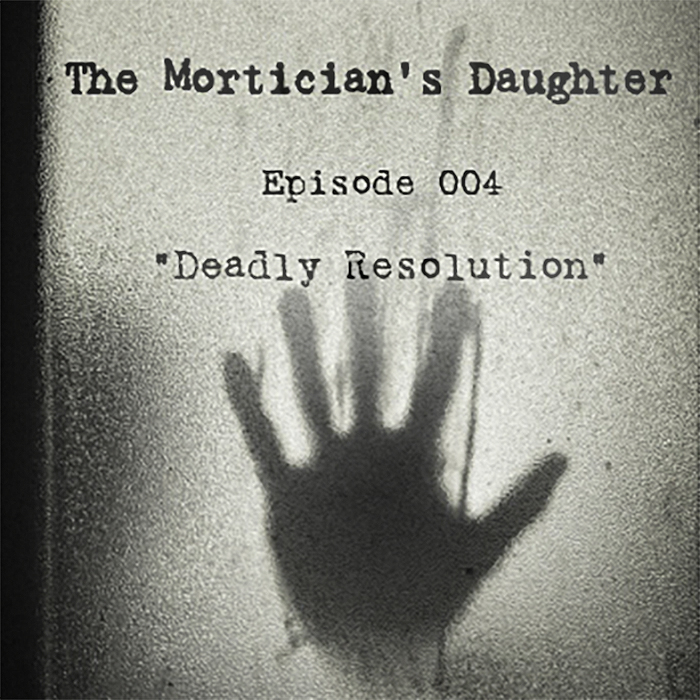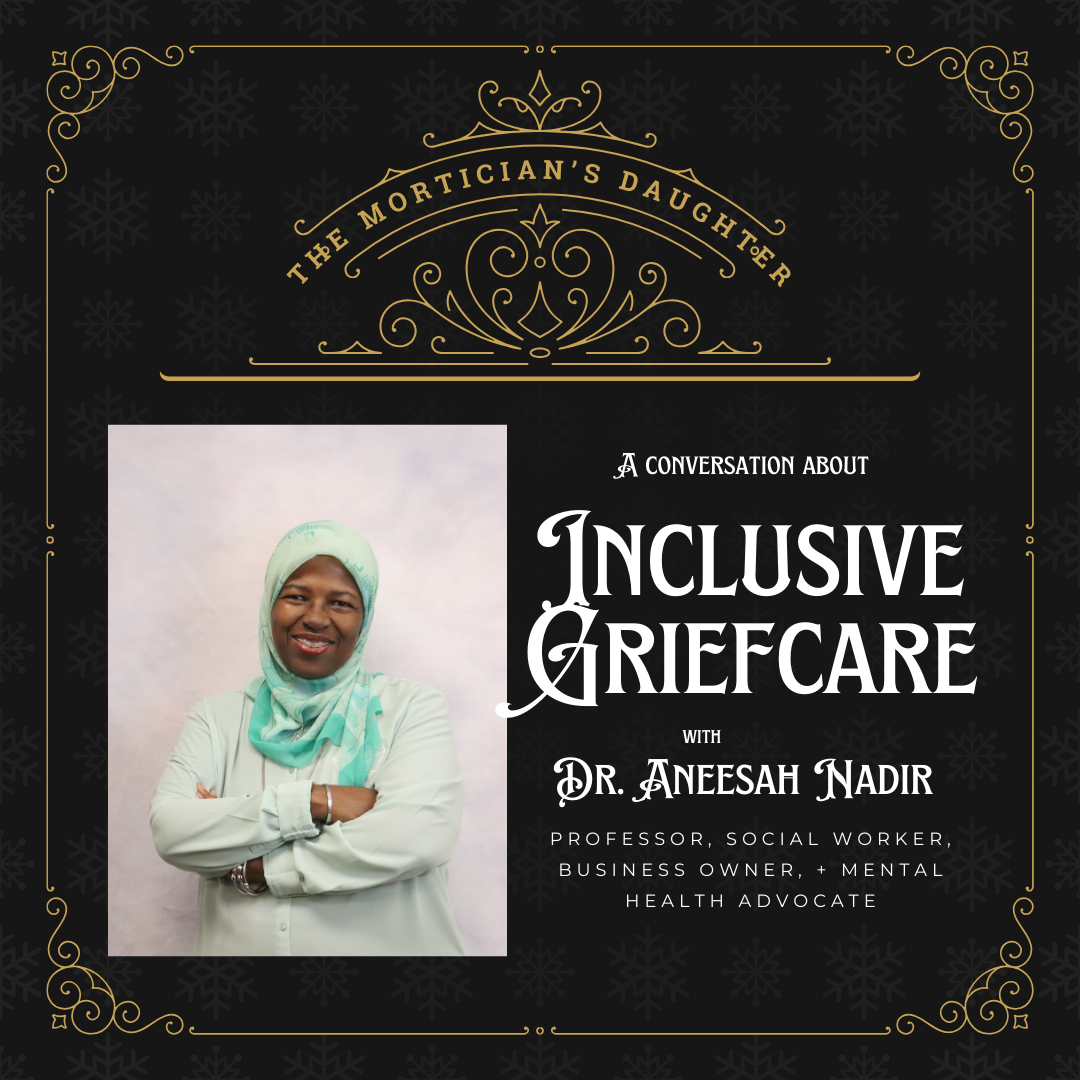Episode Transcript
Hello, hello, my bubalas. I hope everyone is feeling vibrantly alive on this special day… and no matter what day you’re listening to this on, it’s a special day, because we’re together once again. And let me just get our regular reminder to follow or subscribe to our podcast wherever you might be listening out of the way.
We’re keeping the introductions brief today because I’ve been super busy working on our new fiction podcast. If you haven’t checked out our last fiction podcast, Confessions from the Nocturne Nebula, I suggest you give it a listen. Just search for Confessions from the Nocturne Nebula on your preferred podcast platform or you can find us over at YabYumWest.com.
And for today’s episode I’ve decided to talk about some odds & ends I’ve discovered on this podcasting journey of The Mortician’s Daughter. Sometimes my research turns up interesting tidbits that I don’t get to talk about during our brief monthly meditation. So I’ve gathered some favorites here…
I don’t even know where to begin, but since we’re going to be jumping around a lot, I guess it doesn’t really matter.
I know, let’s start with a favorite: The Paradoxical Frog. Pseudis paradoxa, also known as the shrinking frog, is a tree frog that can be found in or near ponds, lakes, lagoons, and rivers of South America. This cute little creature is only about 3.4–7.6 cm long. It’s called the paradoxical frog because, as a tadpole, it measures roughly 27 cm or 11 inches… oftentimes three times the length of the frog. So the paradoxical frog lays eggs and those eggs become the largest tadpoles in the world, for real, and then they shrink to frog size. Hence the name. Most animals do not start off big in infancy and then shrink down… in case you didn’t know that.
Now, you might be asking yourself how this relates to death? Well, it doesn’t really, but we’re here to consider philosophical implications as well, and the paradoxical frog offers us perhaps a better understanding of the absurd or self-contradictory nature of paradoxes. Yes? No? Maybe?
Really, I just wanted to talk about the paradoxical frog, just in case you weren’t aware of its existence. I will add that scientists, back in 2008, discovered that a skin compound which protects the paradoxical frog from infection can also be used to “stimulate the secretion of insulin in pancreatic cells under laboratory conditions without toxicity to the cells” which can aid individuals with Type 2 diabetes. [1] [2]
I guess that makes the paradoxical frog an ally in the fight for life. Other frogs, not so much. Take, for example, the Golden Poison Dart Frog which is the most toxic frog out there in the world, that we know about. It’s scientific name - Phyllobates terribilis - definitely suggests trouble. On average, a Golden Poison Dart Frog produces enough toxins to kill 10 humans which not bad for something that’s about the size of a paperclip. [3] [4]
Now, the golden poison dart frog, or golden frog, is found along the Pacific coast of Colombia and is specific to that area. They prefer to take up residence in the rainforest and, thanks to deforestation, are now listed as an endangered species. These adorable, but very deadly, frogs have morphed over time and created some color variance. The golden frog now also comes in Mint green, orange, and yellow… I can’t really tell the difference between the golden and the yellow, but they’ve been assigned different, albeit similar, scientific names. Maybe I just need to get up close and personal to really see the difference, but I don’t plan on making that happen anytime soon. [5]
Actually, it seems as if the dart frog family takes all the top spots when it comes to the most poisonous frogs on the planet. Listed in order from most poisonous to least, we have the Golden Poison Dart Frog, the Blue Poison Dart Frog, the Black-legged Poison Dart Frog, Strawberry Poison Dart Frog, and the Dyeing Dart Frog. That last one, the dyeing dart frog, is spelled with a d-y-e rather than dying like kicking the bucket or croaking. Ha. Croaking. I crack myself up.
The dyeing dart frog is a personal favorite. These brightly colored frogs come in blue, yellow, and black - usually all at once. The bright colors serve to warn predators and it is also where the frog got its name. According to legend, the skin secretions of the dyeing dart frog were used to dye the feathers of parrots. That’s why parrots are so colorful - at least, according to legend.
[6]
At just 2 inches, the dyeing dart frog is definitely in contention for most adorable threats, but I wouldn’t worry too much about them… unless, of course, you are colorblind and planning on bushwhacking your way through some South American rainforests.
These frogs become poisonous through their diets so when raised in captivity - and not fed toxins that occur in the wild - they are non-poisonous. Which means I might be able to keep a dyeing dart frog at my home without fear it might get lost and murder everyone while we sleep. I mean, they’re just so cute!
Alright, alright, alright, enough about frogs… even deadly one. Other animals can be toxic. And, no, I’m not about to start listing off poisonous creatures, but that might make a good episode. Not today though. I just want to discuss one in particular: humans.
True story. People can be toxic. And I don’t mean toxic like that guy from high school who still sends you weird, crazy hate mail every now and again. I’m sure we all have a couple of those… right? No, I’m not talking toxic in the psychological sense. You can pick up a magazine at the supermarket and read all about that. I’m talking about physical toxicity. Like, don’t touch that person or you risk death. That kind of toxic.
And that’s exactly what happened with Gloria Ramirez, a woman from Riverside, California who turned toxic and unintentionally poisoned hospital staff after they were exposed to her body and blood. Yes, according to Wikipedia, Gloria was “admitted to the emergency department while suffering from late-stage cervical cancer. While treating Ramirez, several hospital workers fainted and others experienced symptoms such as shortness of breath and muscle spasms. Five workers required hospitalization, one of whom remained in an intensive care unit for two weeks.”
The press dubbed her the Toxic Lady. Ramirez died from complications related to cancer. According to an investigation from the Lawrence Livermore National Laboratory that, and I quote, “proposed that Ramirez had been self-administering dimethyl sulfoxide as a treatment for pain, which converted into dimethyl sulfate, an extremely poisonous and highly carcinogenic alkylating agent, via a series of chemical reactions in the emergency department.” There has been some controversy about those findings.
In fact, California's Department of Health and Human Services assigned two scientists to conduct the initial investigation. After interviewing 34 hospital workers, the Department of Health identified two key points. First, they found that those affected tended to be women rather than men, and they all also determined that the afflicted staff had normal blood tests after the exposure. The conclusion the state-assigned scientists came to was, wait for it, mass hysteria.
Yep, mass hysteria. Obviously. I did say more women than men were affected so hysteria must be involved. I should note that a medical resident who was assisting in the trauma room after Ramirez was admitted spent two weeks in the ICU with breathing problems. She also developed hepatitis and avascular necrosis in her knees.
The Riverside Coroner's Office sided with the Lawrence Livermore National Laboratory, but Gloria Ramirez’s family disagreed with those findings. Nevertheless, the Toxic Lady lives on in scientific journals and textbooks, if not in flesh and breath. [7]
And moving right along… so I’d like to take a moment to discuss something that was a serious concern to me as a very young child. Like a lie-awake-and-think-about-it concern. That, the Bermuda Triangle, and the potentially infinite vastness of space were all equal horrors to my second grade self. But, as an adult, I’m fond of all three. So it goes.
Spontaneous human combustion is the rare occurrence wherein a person dies by fire, but without external ignition. That means a person spontaneously bursts into flame. One minute you’re just chilling with some kool-aid and the next minute you’re on fire. Like, a really, really hot fire. So hot that the body is reduced to ash in roughly thirty minutes. Just for a comparison: cremation takes about three hours.
Several purported cases of spontaneous human combustion showed the body burned so quickly that the legs or other extremities were left behind next to a pile of ash.
The death of an Italian Countess named Cornelia Zangari Bandi is generally considered the first case of spontaneous combustion. [11] On March 15th, 1731, the 66-year-old Cornelia retired to bed after a heavy dinner. The Countess was a known brandy drinker who “used to sprinkle camphorated brandy on her body to relieve physical pain” which might be where the association between alcohol and SHC originated.
The Countess did not get up the following morning at her usual hour and when the servants decided to check on her, they found a room filled with soot and a pile of ash where Cornelia slept. However, her legs below the knee, three fingers and front of her skull remained behind, largely intact. [11] I feel it’s pertinent to report that an oil lamp was found near her bed even though it wasn’t thought to be the source of the fire at the time.
More recently, Mary Reeser of St. Petersburg, Florida died on July 2, 1951 by spontaneous human combustion. In this instance, Reeser’s landlady went to deliver a telegram to Mary’s apartment and found the doorknob hot to the touch so she contacted the authorities.
Mary’s ashes were found in her easy chair, but the chair itself did not burn in the fire. Some plastic household items near her remains had “softened and had lost their shape.” Amongst the ash, Reeser’s skull was located and appeared to have shrunken from her fiery end. The FBI was called in to investigate. They determined that “As [Reeser] was a known user of sleeping pills, they hypothesized that she had fallen unconscious while smoking and set fire to her nightclothes.”
So, just how does a body burn so fast and hot that only a pile of ash, and maybe some extraneous limbs, remain? And seemingly without anything to spark the fire? That’s the million dollar question. And just to be clear, I don’t actually have a million dollars to offer anyone who figures out the answer. You’ll just have to accept my sincere thanks and deep appreciation for your work.
Lots of people have put forth theories. In a piece for New Scientist, the work of research biologist and author Brian J. Ford is discussed. Ford tested a number of popular theories about spontaneous human combustion in a laboratory setting and found most didn’t stand up.
Just like the Countess Cornelia, alcohol, or more accurately, alcoholism has been frequently named culprit when spontaneous combustion occurs, but Ford “marinated pork abdominal tissue in ethanol for a week. Even when cloaked in gauze moistened with alcohol, it would not burn.” The truth is, alcohol is not present in our body tissue. Even for you it’s-5-o’clock-somewhere folks.
Ford also disproved another popular theory known as wicking, which is what the FBI pointed to in the case of Mary Reeser. I really don’t want to go into too many details here because it’s pretty gross. Let’s just say the fat in a person’s body ends up working much like the wax in a candle.
And moving right along… ugh… Brian J. Ford did have a theory that he thought held water. This time, he used acetone when marinating the test pork. See, our bodies can produce high amounts of acetone when a person is in ketosis. A lot of us have probably heard of ketosis by now as a dieting trend, but this state in a diabetic or a person suffering from other chronic illnesses can be very dangerous. Now, spontaneous combustion is not listed amongst those risks. Nevertheless, the acetone-treated pork burned to ash in 30 minutes.
Despite Ford’s findings, the general consensus within the scientific community is that most, if not all, cases of spontaneous human combustion are actually just the result of human error - that there has to be an external point of ignition, it’s just simply overlooked.
None too surprising, perhaps, is that cigarettes can be an unidentified culprit in some instances. I say ‘none too surprising’ because it is estimated that one in every four fire deaths is caused by cigarettes. According to a report by Consumer Affairs, “In 1999, smoking-material fires increased 19 percent over the previous year to 167,700, resulting in 807 civilian deaths, 2,193 civilian injuries, and $559.1 million in direct property damage.” [10]
“Most victims were in the room where the fire started, and most had some condition that limited their ability to get out. Often they were asleep, but a significant number were impaired by drugs, alcohol, disability or old age. Indeed, people older than 64 are more likely to die in smoking-material fires than younger people, even though they are less likely to smoke, according to the NFPA.”
I guess there are some additional risks associated with smoking that I was not entirely aware of. Glad I quit.
But fear not, I would say your risk of dying from spontaneous combustion is almost, almost nil. If we turn to good ol’ Wikipedia, they cite Larry E. Arnold, a director of ParaScience International, who asserts there are “about 200 cited reports of spontaneous human combustion worldwide over a period of around 300 years.”
Brian J. Ford puts that number a bit lower, at only 120 cases. And, as forensic science continues to advance, I wonder if we won’t see that rate of “human spontaneous combustion” dip even lower.
And look at that! We’re just about out of time here. I guess I’ll have to save some of these titillating topics for a later episode. So let’s close out the show with a quote from the mighty Jimi Hendrix: “I’m the one that's got to die when it's time for me to die, so let me live my life the way I want to."
Yep, I’m onboard. Until next time, I hope each coming day is another opportunity to live your life the way you want to… crimes against others and internet trolling excluded.
[1] https://en.wikipedia.org/wiki/Pseudis_paradoxa
[2] https://www.degruyter.com/document/doi/10.1515/BC.2008.018/html
[3] https://www.treehugger.com/beautiful-deadly-frogs-4859270
[4] https://www.nationalgeographic.com/animals/amphibians/facts/golden-poison-frog
[5] https://en.wikipedia.org/wiki/Golden_poison_frog
[6] https://www.zoonewengland.org/stone-zoo/our-animals/reptiles-amphibians/dyeing-poison-dart-frog/
[7] The Toxic Lady - https://en.wikipedia.org/wiki/Death_of_Gloria_Ramirez
[8] https://en.wikipedia.org/wiki/Spontaneous_human_combustion
[9] http://www.brianjford.com/a-1208-NSci-SHC.pdf
[10] https://www.consumeraffairs.com/news04/cigarette_fires.html
[11] https://en.wikipedia.org/wiki/Cornelia_Zangheri_Bandi


